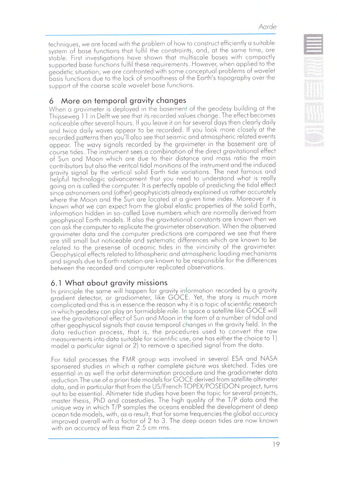Aarde
6 More on temporal gravity changes
6.1 What about gravity missions
techniques, we are faced with the problem of how to construct efficiently a suitable
system of base functions that fulfil the constraints, and, at the same time, are
stable. First investigations have shown that multiscale bases with compactly
supported base functions fulfil these requirements. However, when applied to the
geodetic situation, we are confronted with some conceptual problems of wavelet
basis functions due to the lack of smoothness of the Earth's topography over the
support of the coarse scale wavelet base functions.
When a gravimeter is deployed in the basement of the geodesy building at the
Thijsseweg 1 1 in Delft we see that its recorded values change. The effect becomes
noticeable after several hours. If you leave it on for several days then clearly daily
and twice daily waves appear to be recorded. If you look more closely at the
recorded patterns then you'll also see that seismic and atmospheric related events
appear. The wavy signals recorded by the gravimeter in the basement are of
course tides. The instrument sees a combination of the direct gravitational effect
of Sun and Moon which are due to their distance and mass ratio the main
contributors but also the veritcal tidal monitions of the instrument and the induced
gravity signal by the vertical solid Earth tide variations. The next famous and
helpful technologic advancement that you need to understand what is really
going on is called the computer. It is perfectly apable of predicting the tidal effect
since astronomers and (other) geophysicists already explained us rather accurately
where the Moon and the Sun are located at a given time index. Moreover it is
known what we can expect from the global elastic properties of the solid Earth,
information hidden in so-called Love numbers which are normally derived from
geophysical Earth models. If also the gravitational constants are known then we
can ask the computer to replicate the gravimeter observation. When the observed
gravimeter data and the computer predictions are compared we see that there
are still small but noticeable and systematic differences which are known to be
related to the presense of oceanic tides in the vincinity of the gravimeter.
Geophysical effects related to lithospheric and atmospheric loading mechanisms
and signals due to Earth rotation are known to be responsible for the differences
between the recorded and computer replicated observations.
In principle the same will happen for gravity information recorded by a gravity
gradient detector, or gradiometer, like GOCE. Yet, the story is much more
complicated and this is in essence the reason why it is a topic of scientific research
in which geodesy can play an formidable role. In space a satellite like GOCE will
see the gravitational effect of Sun and Moon in the form of a number of tidal and
other geophysical signals that cause temporal changes in the gravity field. In the
data reduction process, that is, the procedures used to convert the raw
measurements into data suitable for scientific use, one has either the choice to 1
model a particular signal or 2) to remove a specified signal from the data.
For tidal processes the FMR group was involved in several ESA and NASA
sponsered studies in which a rather complete picture was sketched. Tides are
essential in as well the orbit determination procedure and the gradiometer data
reduction.The use of a priori tide models for GOCE derived from satellite altimeter
data, and in particular that from the US/French TOPEX/POSEIDON project, turns
out to be essential. Altimeter tide studies have been the topic for several projects,
master thesis, PhD and casestudies. The high quality of the T/P data and the
unique way in which T/P samples the oceans enabled the development of deep
ocean tide models, with, as a result, that for some frequencies the global accuracy
improved overall with a factor of 2 to 3. The deep ocean tides are now known
with an accuracy of less than 2.5 cm rms.
19

